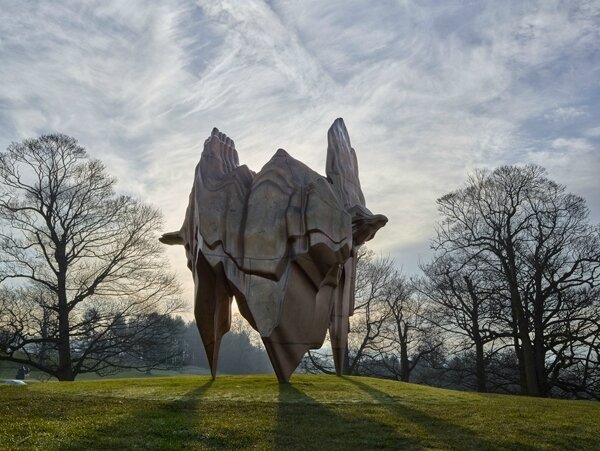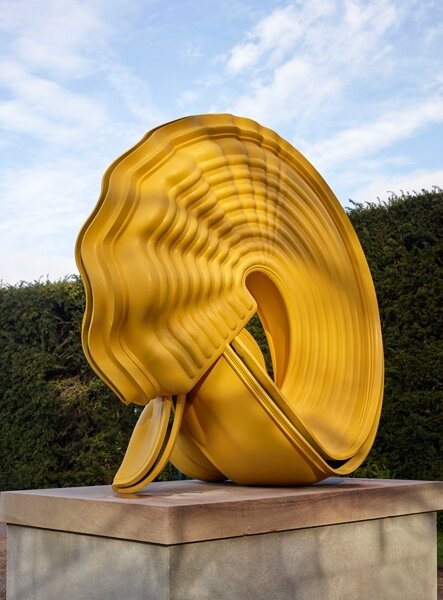![An exceptionally rare and large fine blue and white reserve-decorated 'peony' dish, Xuande mark and period]()
![1]()
![2]()
![3]()
![4]()
![5]()
![6]()
![7]()
![8]()
![9]()
![10]()
![11]()
Lot 6. An exceptionally rare and large fine blue and white reserve-decorated 'peony' dish, Xuande mark and period (1426–1435). Estimate 1,000,000 — 1,500,000 USD. Photo: Sotheby's.
well potted, the shallow rounded sides rising from a short tapered foot to a delicately everted rim, boldly decorated to the interior with a large peony bloom borne on a leafy stem enclosed within a single-line border and framed at the well by fruiting branches of loquat, cherry, persimmon, peach, lychee and pomegranate, the exterior decorated with a continuous chrysanthemum scroll, all finely incised and reserved against a rich 'royal blue' glaze, beneath a further transparent glaze, the six-character mark inscribed in underglaze blue in a horizontal line reserved in a rectangular cartouche just below the rim, the unglazed base burnt orange. Diameter 15 1/4 in., 38.6 cm
Provenance: Collection of Baron Guy de Villelume (1908-1991), Château de La Gorgue, France (until 1988).
A French Private Collection.
This magnificent, large ‘royal blue’ dish was made to impress the imperial court and reflects the search for new classics at China’s imperial porcelain kilns during the Xuande reign (1426-1435). Its extremely rare reverse decoration technique had been experimented with already in the late Yuan period (1279-1368), but in order for it to find favor at the early Ming court (1368-1644) it needed to be refined technically. The Xuande period is marked by a sudden keen imperial interest in ceramics. While in the Yongle reign (1403-1424), many of the finest items made at Jingdezhen were still sent abroad, in the Xuande period, with the generalized use of the imperial reign mark, production at the imperial kilns appears to have been destined almost exclusively for the palace.
Although the rich cobalt-blue ground worked spectacularly well to highlight bright fruit and flower designs, the material costs – due to the high quality and quantity of cobalt required – and the technical expertise required by the indirect reserve decoration process probably made production on a larger scale of wares in this style impractical even for the imperial kilns. The production time would have far exceeded that of dishes painted in the positive, in blue on white, so that this technique was clearly not suited for production in larger numbers. Apart from occasional trials, it was more or less abandoned after the Xuande reign, to be properly revived again – like many other early Ming styles – only in the Yongzheng period (1723-1735).
The resist technique as used on this dish appears complicated. The design was first incised into the unfired white body and the mark on the outside inscribed in underglaze blue. Then either the design only or the complete inside and outside – opinions vary – was or were covered with a transparent glaze, and subsequently the background around the design with a blue glaze. The plain rings around the center and the foot, however, appear as if scratched through the blue glaze, and in some areas, more transparent glaze appears to have been added after the blue, creating in places a very thick white layer, which has partly obscured the incising. The overall effect was much refined since the Yuan dynasty, the surface being smooth and even, without any gaps where blue meets white.
Only three other dishes of this decoration technique, design and size appear to be recorded. Although the silhouette effect seems at first glance almost stencil-like, since the basic composition is always the same, each dish is individually hand-decorated and varies from the next. On a companion dish in the Museum of Oriental Ceramics, Osaka, from the Ataka collection, for example, the two parallel stems in the center, of which one belongs to the main peony bloom and the other to the small bud and leaves behind it, seem to have been inadvertently overpainted in blue, so that the bloom appears to be floating. Yet overall, the dish obviously pleased the courtly quality control in the Xuande reign (so that rejection was not considered), as it still does today: in Japan the dish has been designated as ‘Important Cultural Property’. The dish has been frequently illustrated and exhibited; it is published, for example, in Sekai tōji zenshū/Ceramic Art of the World, vol. 14, Tokyo, 1976, col. pl. 30; and was included in Chūgoku no tōji/Special Exhibition of Chinese Ceramics, Tokyo National Museum, Tokyo, 1994, cat. no. 267.
Another dish of this design, in the Palace Museum, Beijing, is illustrated Mingdai Xuande yuyao ciqi/Imperial Porcelains from the Reign of Xuande in the Ming Dynasty, Beijing, 2015, pl. 89; and a third such dish, also formally in the collection of Baron Guy de Villelume in France, where it was displayed together with the present dish, was sold at Christie’s Hong Kong, 2nd December 2015, lot 3112.
![12]()
Lot 3112. An exceptionally rare large blue and white reserve-decorated ‘peony’ dish, Xuande six-character mark in underglaze blue in a line and of the period (1426-1435). Estimate HK$15,000,000 - HK$25,000,000 ($1,944,540 - $3,240,900). Price Realized HK$20,280,000 ($2,629,018). Photo Christie's Image Ltd 2015
(Cf. my post: An exceptionally rare large blue and white reserve-decorated ‘peony’ dish, Xuande six-character mark and of the period)
This peony design with fruit sprays inside and a chrysanthemum scroll outside is otherwise very rarely seen in any coloration, but was executed at the Jingdezhen imperial kilns equally in cobalt-blue on white, in iron-brown on white, and in cobalt-blue against a yellow background, very similarly conceived in all versions, with even the fruit sprays distributed around the center in the same order and at the same coordinates; rejected examples of all three styles from the imperial kiln site were included in the exhibition Jingdezhen chutu Ming Xuande guanyao ciqi/Xuande Imperial Porcelain Excavated at Jingdezhen, Chang Foundation, Taipei, 1998, cat. nos 85-1 to 85-3 (figs 1-3); and a successfully fired example with this design in a very pale café-au-lait colour is in the Shanghai Museum, see Lu Minghua, Shanghai Bowuguan zangpin yanjiu daxi/Studies of the Shanghai Museum Collections: A Series of Monographs. Mingdai guanyao ciqi [Ming imperial porcelain], Shanghai, 2007, pl. 3-50 (fig. 4).
![A large brown and white reserve-decorated ‘peony’ dish, Xuande mark and period © Jingdezhen Ceramics Archaeology Institut]()
Fig. 1. A large brown and white reserve-decorated ‘peony’ dish, Xuande mark and period© Jingdezhen Ceramics Archaeology Institut
![A large blue and white ‘peony’ dish, Xuande mark and period]()
Fig. 2. A large blue and white ‘peony’ dish, Xuande mark and period© Jingdezhen Ceramics Archaeology Institute
![A large yellow-ground blue and white ‘peony’ dish, Xuande mark and period]()
Fig. 3. A large yellow-ground blue and white ‘peony’ dish, Xuande mark and period. © Jingdezhen Ceramics Archaeology Institute
![A large brown and white ‘peony’ dish, Xuande mark and period]()
Fig. 4. A large brown and white ‘peony’ dish, Xuande mark and period© Shanghai Museum
Only about a dozen related Xuande dishes are known, all except one of smaller size. The one larger dish is a broken piece in the Meiyintang collection, illustrated in Sekai bijutsu taizenshū /New History of World Art: Tōyō hen [Oriental section], vol. 8: Min [Ming], Tokyo, 1999, pl. 144, sold in our London rooms, 10th November 2004, lot 590, and published in Regina Krahl, Chinese Ceramics from the Meiyintang Collection, London, 1994-2010, vol. 4, no. 1667.
The waste heaps of the Jingdezhen kiln sites also brought to light sherds of a somewhat smaller dish (35 cm) decorated with a daylily – a pattern, of which no perfect example appears to survive – which was exhibited in reconstructed form at the Chang Foundation, Taipei, 1998, op.cit., cat. no. 82-3.
Otherwise dishes decorated in this technique are known in two well-known designs that later became very popular painted in blue against a yellow ground, both smaller: one with a flowering pomegranate branch, the other with gardenia in the center, both surrounded by four fruiting branches. Six dishes (approximately 29 cm) are known of the pomegranate design: in the National Palace Museum, Taiwan, included in the exhibition Mingdai Xuande guanyao jinghua tezhan tulu/Catalogue of the Special Exhibition of Selected Hsüan-te Imperial Porcelains of the Ming Dynasty, National Palace Museum, Taipei, 1998, cat. no.198; in the Palace Museum, Beijing, see Geng Baochang, ed., Gugong Bowuyuan cang gu taoci ciliao xuancui [Selection of ancient ceramic material from the Palace Museum], Beijing 2005, vol. 1, pl. 111; in the Asia Society, New York, from the Sedgwick and Rockefeller collections, illustrated in Denise Patry Leidy, Treasures of Asian Art: The Asia Society’s Mr. and Mrs. John D. Rockefeller 3rd Collection, New York, 1994, pl. 178, and sold twice in our London rooms, 9th November 1954, lot 72, and 2nd July 1968, lot 122; and another was sold in our Hong Kong rooms, 8th April 2007, lot 839, and is illustrated in Julian Thompson, The Alan Chuang Collection of Chinese Porcelain, Hong Kong, 2009, cat. no. 13. A second dish of this design from the Sedgwick collection, also attributed to the Xuande period, but unmarked, is illustrated in Jessica Harrison-Hall, Ming Ceramics in the British Museum, London, 2001, no. 4:41; and a deliberately destroyed example recovered from the waste heaps of the Ming imperial kiln site at Jingdezhen, was exhibited at the Chang Foundation, Taipei, 1998, op.cit., cat. no. 84.
All these dishes have the mark reserved in a cartouche below the rim, like the present piece, and the unglazed bases tend to be burnt a vivid orange to a dark reddish brown, perhaps due to application of an iron-rich wash, although this seems to be missing on the Ataka example. Smaller dishes decorated in this technique (c. 25 cm), of the gardenia pattern, have a glazed base with the regular reign mark inscribed within a double circle. Six dishes of this smallest size are recorded, of which three are in the National Palace Museum, Taipei, see the Museum’s 1998 exhibition, op.cit., cat. no. 82, and Soame Jenyns in Transactions of the Oriental Ceramic Society, vol. 31, 1957-59, pl. 6c; one in the Guangdong Provincial Museum, see Zhongguo taoci quanji [Complete series on Chinese ceramics], vol. 13, Shanghai, 2000, pl. 26; one in the Anhui Provincial Museum, illustrated in Wenwu 1982, no. 9, p. 20, figs 1 and 2; and one, sold in our London rooms, 13th March 1973, lot 235, published in Tōji taikei, vol. 42, Tokyo, 1975, col. pl. 15 and p. 129, fig. 15, today probably in a private Japanese collection.
This latter gardenia design was closely copied in the Qing dynasty (1644-1911), see Lu Minghua, op.cit., pl. 5-33, for an example in the Shanghai Museum attributed to the Yongzheng period, when pieces with contemporary white-against-blue designs were also produced in this technique, see Krahl, op.cit., vol. 2, no. 843. A blue-glazed ground was in the Xuande period also used for a few bowls and small dishes with reserved fish-pond designs, which are executed, however, in a slightly different technique, with details painted in slip.
Sotheby's. Ming: The Intervention of Imperial Taste, New York, 14 mars 2017, 10:00 AM








































































































